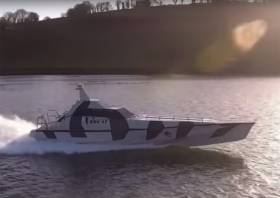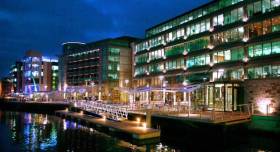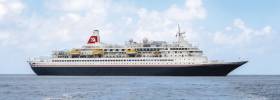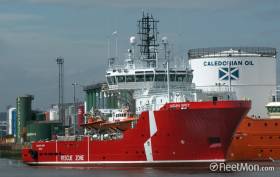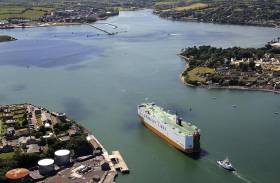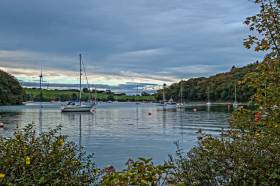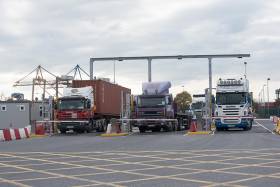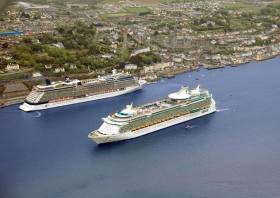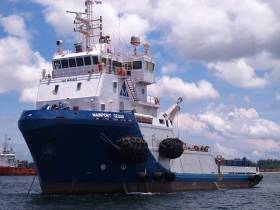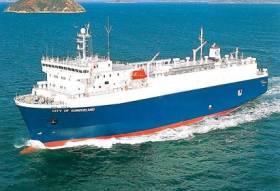Displaying items by tag: port of Cork
Safehaven’s ‘Thunder Child’ Put Through Its Paces In Stormy Cork Harbour
#ThunderChild - Stormy winter seas made the perfect proving ground for a new state-of-the-art naval patrol and rescue vessel tested in Cork Harbour recently, as the Irish Examiner reports.
But it’s just the beginning for Thunder Child – the latest high-tech design from Cork-based Safehaven Marine, makers of the James Bond-style Interceptor, Barracuda – which was launched from the Port of Cork last month.
Safehaven’s managing director Frank Kowalski has his sights set on breaking the record for the fastest circumnavigation of Ireland — including a 1,000km open-sea loop around Rockall.
And considering the sleek wave-cutting vessel has already clocked speeds of over 100kph in testing, and is kitted out to handle the stormiest situations, it should be well up to the task of that challenging route.
The Irish Examiner has more on the story HERE.
Cork 'City Quarter' Boardwalk In €14m Deal
#CityQuarter - In a deal worth up to €14m writes The Irish Examiner, is to be signed in the coming days on a remaining investment — including the Boardwalk bar and restaurant — at Cork city’s seminal City Quarter.
It went to market for Nama in September 2016, guiding €14.5 million.
The investment offer, including remaining 38,000 sq ft of offices, basement car parking and ground floor space at the €100m City Quarter, is close to being bought in one single lot, according to sources. It has an income of €654,000 with scope to double that to €1.33m, according to Savills.
It’s understood that one investor is behind the impending deal, and when concluded, it may involve a re-sale or sub-sale as well as leases of several of the key components.
Click here for more on the deal at the site which Afloat adds is directly opposite to Ardmore Shipping Corporation's 'Irish' office on Albert Quay.
The Bermuda headquartered corporation of a product/chemical tanker fleet, relocated last summer its principle operating office to Cork City from the suburb of Mahon downriver.
Last month several key appointments were made by Ardmore to their offices in Singapore and Houston, USA.
Quartet of Cruiseships Coming to Cork for Christmas
#CobhChristmasCall - A quartet of cruiseships will come to Cork Harbour this festive season, including one on Christmas Day, bringing 5,000 visitors to the region.
The increase writes the Evening Echo in winter cruiseships highlights a changing industry. Cork traditionally welcomes cruiseships into Cobh from April to October, and 58 vessels arrived this year.
The larger ocean liners are then redeployed to the Caribbean, the Meditteranean, or to the southern ocean around Australia. However, increased competition means vessels operated by UK and German cruise companies are continuing in northern Europe throughout the winter.
Earlier this week, the Bodicea called to Cobh and will be followed by the Balmoral, on Saturday, and the Marco Polo, on Monday. Then, on Christmas Day, Black Watch, operated by Fred Olsen Cruise Lines, will come to Cobh. The four vessels have a capacity of 5,600 passengers and crew.
For more from Captain Michael McCarthy, the commercial manager of the Port of Cork, click here.
Shipping Snapshot: Cork Harbour's Diverse Range of Vessels
#PortSnapshot - Shipping movements in the Port of Cork have included in recent days a diverse range of vessels that are based and have visited the natural harbour, writes Jehan Ashmore.
Outlined below are vessels that Afloat.ie have tracked and their respective business activity.
Kinsale GasField Supply Support Ship: Ocean Spey a supply tug support vessel, newly introduced at the Kinsale Energy Ltd facility (formerly Marathon Oil) is currently operating offshore. The 66m vessel is reported to be registered in Ireland and is serving the pair of gas rig platforms located approximately 50kms off the south coast of Cork. Afloat will have more to report on Ocean Spey.
The vessel which also has anchor handling capabilities was built in 2000 and has a 1,864 gross tonnage. Meanwhile the main Kinsale Gasfield standby support ship, Pearl, operated by Cork based Mainport Group, (owners subsidiary Seahorse), is currently at the lay-by berth at Cork Dockyard, Rushbrooke near Cobh.
Brittany Ferries Flagship Service: Pont-Aven, Brittany Ferries flagship of 41,700 gross tonnage made her final Cork-Roscoff end of season sailing on Saturday.
In advance of the season the cruiseferry was fitted with 'scrubbers' to reduce harmful sulphur emissions (the only ferry in Irish waters with this 'green' technology as previously explained here).
The Ireland-France route began in 1978, the same year gas was first produced from the Kinsale Head area in the Celtic Sea. The 2,400 passenger/650 car ferry is to resume service in April, 2017.
Dutch Naval Submarine: A more unusual sight to Cork Harbour has been submarine HNLMS Bruinvis of the Royal Netherlands Navy (NATO member). The non-nuclear powered 68m submarine built during the Cold War is equipped with almost 40 torpedoes missiles.
The crew having paid a visit to Cork City for a long weekend departed yesterday using its diesel electric engines.
Photographs Needed for Port of Cork 2017 Calendar
Every year the Port of Cork Company compiles a much sought after calendar of Port and harbour photos. Over the years the themes and designs have varied from old style maritime paintings, historic photos of the port demonstrating the ports history and Cork Harbour as a trade gateway, to photographs of today’s port, a modern dynamic and busy facilitator of imports and exports.
With so many trade and leisure visitors to our Port, every day is different and thanks to some keen photographers out there, much of this activity is captured in photographs and shared via social media.
The Port of Cork is now compiling the calendar for 2017 and is inviting photographers both amateur and professional, if interested to submit a photo. All photos should be port activity or Cork harbour related. Fourteen photographs will be selected for the calendar and photographers whose photos are chosen will receive a copy of the Port of Cork calendar and a credit within the calendar.
The calendar is printed and distributed compliments of the Port of Cork to port users and customers. Every year over 1000 calendars are distributed.
If you are interested in submitting a photograph (max 2 photos per submission) please send your images to Sara MacKeown [email protected] along with your name and contact details. All images must be landscape and high resolution Jpg format. Closing date for submissions 17th November.
Port of Cork Venue for 2017 ISA Cruising Conference
After the inaugural success of the Howth Yacht Club 2016 Cruising Conference, the Irish Sailing Association is bringing the one day event to Cork Harbour at the Port of Cork Offices on Saturday, 18th February 2017.
Last year's conference featured a wide range of topics and featured on Afloat.ie here.
Port of Cork's New Automated Gate Operating System is First in Ireland
The Port of Cork Company (POCC) has announced the recent introduction of a new €750,000 automated gate operating system for its Tivoli Container Terminal. The new system will help support terminal efficiency and modernise the container collection and delivery process at the busy marine terminal and it is the first of its kind to be introduced in Ireland.
The Port have implemented an integrated IT access management system that will improve transactions for hauliers at the terminal gate. The new gate operating system replaces the former gate-in and gate-out procedure, which operated for many years at the terminal, and is the culmination of a five year objective. Included in the process was a joint collaboration between the Port of Cork and Customs & Revenue to establish a customs clearance verification system.
The new high-tech Gate Operating System will record important data for all deliveries and collections at the Terminal, including license plates, container details, container damages and security seal presence and utilizes modern technologies and industry practices observed at terminals operating in mainland Europe.
In the event of any difficulty, the new Gate Operating System contains a problem resolution area where any potential issues encountered by the haulier can be addressed prior to containers being delivered and/or collected. Only those trucks that have been processed correctly can enter the Container Terminal Gate and the Loading/Unloading area, which improves flow at the busy interface. The new Gate Check in Area is monitored by a central control station and can also assist hauliers as required.
Olan O’Keeffe, Terminal Operations Manager, Port of Cork, says, “Ports and terminals are dynamic environments with very specific needs and the Port of Cork Company prides itself on being at the forefront of the industry when it comes to adapting to change and in consistently achieving the highest operational standards”.
“The introduction of this modern Gate Operating System will assist in improving terminal turnaround times, increase our throughput capacity, improve efficiency, drive revenue, integrate with Customs systems and provide us with important management reporting data such as how many trucks visited the terminal during a particular day, week or month and how long trucks stayed at the terminal on average. Image recording will also assist us in claims management.”
He continued, “The introduction of the Gate Operating System at Tivoli will also contribute to the Port’s plans to develop its new facility at Ringaskiddy. As part of that proposal the Port has committed to implementing a Traffic Mobility Management plan in Ringaskiddy, and a fully automated gate system and vehicle booking system will form an important part of that Plan. The new system at Tivoli will provide us with valuable hands on experience of what such a facility can contribute to traffic mobility”.
The continued use of the Port’s online portal (portal.portofcork.ie) is recommended to hauliers to ensure containers are booked in, released and customs cleared, etc. Further developments are planned to improve information for transport operators through this portal, in order to communicate key information that will be required in relation to the availability of containers for customers.
No Single Port – Ireland Needs Them All for Cruise Ship Business
The cruise ship industry is a huge and growing business …. The “ship hotel” as it has been dubbed. There is huge competition amongst the companies which own the ships and amongst the ports which want them to call. More, bigger cruise ships than ever have been and are being built, with ever-bigger passenger capacity. The Cruise Line International Association Europe said last year that the contribution of Cruise Ship Tourism to the economies of Europe was worth €40 billion and accounted for nearly 350,000 European jobs and that Europe was the second biggest market worldwide, after the United States.
Ireland has been attracting plenty of cruise ship business. Last year 193 vessels called to Irish ports - Dublin and Cork being the main locations, followed by Waterford, with Dun Laoghaire, Killybegs, Foynes and Bantry Bay also calling-locations. That number of ships was an increase of 16 and the number of passengers was close to 250,000 – an increase of almost 40,000 - on the previous year. As dictated by Government policy, the ports are in competition with each other and the cruise ship business is one of their primary targets, though port administrations say that local businesses and the economy generally benefits more than they do from calls by cruise ships.
With more ships being built, many with bigger-than-ever passenger capacity, is the best approach for Ireland that its ports should be competing with each other for the business?
That’s the question I have been discussing on THIS ISLAND NATION Podcast this week, with a man in a position to see both sides, Capt. Michael McCarthy is Cork Port’s Commercial Manager and also Chairman of Cruise Europe. I talked to him in Cobh, as the town celebrated its latest international award for the handling of cruise ships.
• Listen to the Podcast below:
#UNship - Mainport Cedar, which carried out a UN World Food Program to war-torn Yemen is on her first visit to Cork City where her Irish owners are based, writes Jehan Ashmore.
It was during the 9 month contract to the UN that the seismic support vessel which also is a supply ship carried out the unusual role of making humanitarian transportation voyages. The charter of the ship to the Arab country ceased earlier this year.
Mainport Cedar has accommodation for 50 (10 officers and 40 marine crew) and a 1-bed hospital unit. During its UN charter role, the vessel transported UN personnel to Yemen.
As previously reported the 1,659 gross tonnage ship is the leadship of a pair built in Malaysia as the first purpose built seismic support ships for the Mainport Group. The 2013 built ship is berthed at Cork along Albert Quay, adjacent to the Port of Cork’s City Centre Marina.
The reason for the first call of the 53m vessel is due to the completion of a project in the Bristol Channel.
As for the next project, it would appear that Mainport Cedar is next bound for Nassau, Bahamas, though Mainport declined to confirm that the Caribbean island is the next area of operation.
Operating much closer to home, Mainport have the contract to serve the Kinsale Gas Field. This is carried out by the multi-role support vessel Pearl out of Ringaskiddy, lower Cork Harbour. It was here that Celtic Fergus, the latest acquisition for subsidiary Celtic Tugs was delivered by cargoship earlier this year.
Reports of Nissan Eyeing Up Cork Site "Just Not True"
#CorkCars? - Nissan Europe have dismissed speculation, writes TheJournal.ie, that it is interested in taking over a site south of Cork City at the 130-acre former Amgen facility in Carrigtwohill.
Fianna Fáil city councillor Kenneth O’Flynn had claimed that he had been tipped off by industry insiders that the Japanese automobile production giant may be interested in locating to east Cork.
Nissan Europe’s lukewarm response as to whether it was fully committed to Sunderland in the north- east of the UK in the wake of Brexit had increased speculation about its future plans.
However, a spokesperson for Nissan Europe was unequivocal in her response when contacted by the Evening Echo. She said: “There’s nothing to this tip-off.”
To read more and of the FF councillor views on the use of Port of Cork click here.
In addition see: Seatruck’s new Dublin-Bristol trade car route that follows in the wake of 1970's car industry serving Dublin and notably the Port of Cork and related former Ford assembly plant.


























